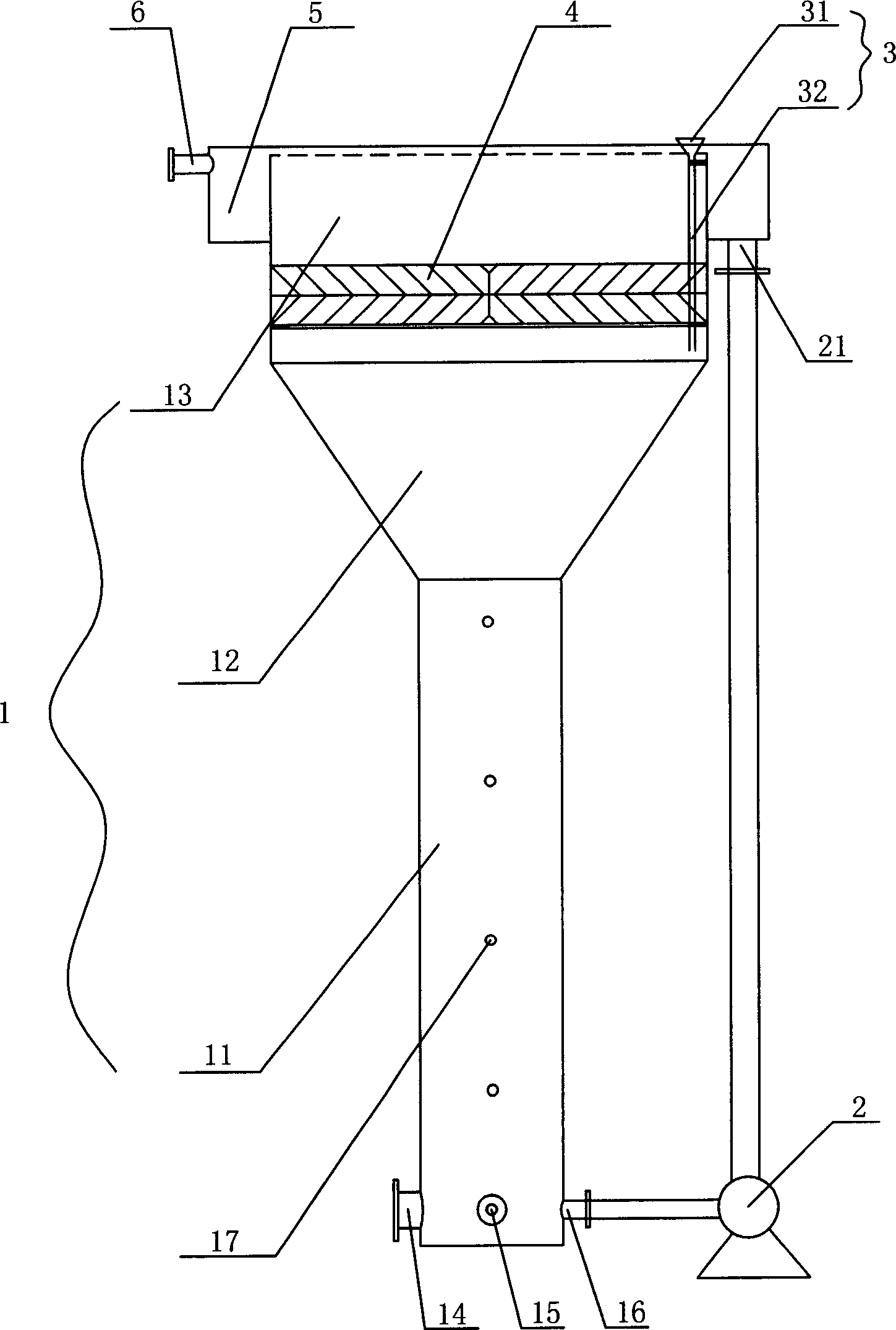Method and equipment for removing organic chloride from wastewater
An organic chloride and wastewater technology, applied in chemical instruments and methods, chemical/physical processes, reduced water/sewage treatment, etc. Simple design and construction, favorable for particle settling and improved stability
- Summary
- Abstract
- Description
- Claims
- Application Information
AI Technical Summary
Problems solved by technology
Method used
Image
Examples
Embodiment 1
[0073] The reducing agent is pure iron particles, and the catalyst is soluble sulfate with a particle size of 60 mesh. It is used to treat organic chlorine wastewater. A variable diameter fluidized bed is used. The diameter of the fluidized reaction section 11 is 2.40 meters, and the diameter of the sedimentation section 13 is 7.8 meters. The bottom of the equipment circulates water tangentially to form a swirling flow, and the fluid Reynolds number Re is 48500; the fluidization reaction section 11 forms a turbulent flow, and the fluid Reynolds number Re is 24500; the sedimentation section 13 is provided with a spiral inclined plate of a sedimentation separation member, and the fluid is an approximate layer flow, the fluid Reynolds number Re is 0.79. For every 1 ton of wastewater treated, 2kg iron powder and 0.2kg catalyst were added. Under the conditions of room temperature and atmospheric pressure, the concentration of carbon tetrachloride in the wastewater influent was 20mg / ...
Embodiment 2
[0075] Platinum is used as a catalyst, which is loaded on the surface of reducing agent iron particles, with a particle size of 40 mesh, to treat organic chlorine wastewater. A variable diameter fluidized bed is used. The diameter of the fluidized reaction section 11 is 1.40 meters, and the diameter of the sedimentation section 13 is 3.76 meters. The tangential circulating water at the bottom of the equipment forms a swirling flow, and the fluid Reynolds number Re is 26500; the fluidization reaction section 11 forms a turbulent flow, and the fluid Reynolds number Re is 6000; the sedimentation section 13 is provided with a precipitation separation member inclined plate, and the fluid is approximately laminar flow , the fluid Reynolds number Re is 0.37. For each 1 ton of wastewater treated, 1-2 kg of iron powder loaded with catalyst platinum was added. Under the conditions of room temperature and atmospheric pressure, the concentration of carbon tetrachloride in the wastewater in...
Embodiment 3
[0077] Palladium is used as a catalyst, which is loaded on the surface of iron particles to treat organic chlorine wastewater. The particle size is 30 meshes. A variable diameter fluidized bed is used. The diameter of the fluidized reaction section 11 is 0.70 meters, and the diameter of the sedimentation section 13 is 2.5 meters. The bottom of the equipment is tangentially circulated with water to form a swirling flow, and the fluid Reynolds number Re is 36500; the fluidization reaction section 11 forms turbulent flow, and the fluid Reynolds number Re is 21000; the sedimentation section 13 is provided with a spiral inclined plate of a sedimentation separation member, and the fluid is an approximate layer flow, the fluid Reynolds number Re is 0.98. For each 1 ton of wastewater treated, 0.5-2kg of iron powder loaded with catalyst palladium was added. Under the conditions of room temperature and atmospheric pressure, the concentration of vinyl chloride in the influent of the waste...
PUM
 Login to View More
Login to View More Abstract
Description
Claims
Application Information
 Login to View More
Login to View More - R&D
- Intellectual Property
- Life Sciences
- Materials
- Tech Scout
- Unparalleled Data Quality
- Higher Quality Content
- 60% Fewer Hallucinations
Browse by: Latest US Patents, China's latest patents, Technical Efficacy Thesaurus, Application Domain, Technology Topic, Popular Technical Reports.
© 2025 PatSnap. All rights reserved.Legal|Privacy policy|Modern Slavery Act Transparency Statement|Sitemap|About US| Contact US: help@patsnap.com



